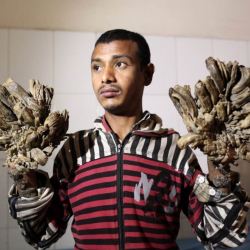You may have noticed a number of headlines referencing the “Tree Man” from Bangladesh with claims he is “cured” after 16 operations for his rare genetic disorder that transformed his hands and feet into bark-like warts and cutaneous horns.
Also called Epidermodysplasia Verruciformis (EV), this debilitating, heritable condition is often referred to as “Tree Man Illness” or “Tree Man Syndrome.” Though it manifests throughout the body via innumerable abnormal growths on the skin, it is considered to be caused by a genetic impairment that triggers a defect in a person’s cell-mediated immunity.
More than 200 cases have been reported since it was first described in 1922 by two dermatologists, hence, its other name “Lewandowsky Lutz Dysplasia.” (1) Most present in childhood with continued symptom development throughout life. 195 cases have appeared in Eastern Europe, Poland, and Latin America. (2)
Basically, due to this defect in an individual’s immune system, a sufficient response to HPV (aka human papilloma virus) can’t be mounted; and, as a result, the person battles this infection chronically with the diffuse and overgrown warts and skin abnormalities that accompany it. Most are benign lesions, while some have oncogenic (aka cancer-causing) potential. The risk of malignant conversion of these lesions can be high so avoidance of the sun (e.g. Ultraviolet A & B radiation exposure) along with radiation from X-rays is of critical import.
Squamous cell carcinoma is the typical skin cancer that presents in this population, usually abounding in the fourth and fifth decade of life. However, depending on lifestyle (e.g. living in a tropical climate, altitude) and occupation (e.g. farmer), this progression can occur well in advance of those ages. So, it is recommended that those who suffer from this ailment opt for better suited occupations where sun can be avoided and emphasize sunscreen.
The lesions will begin to appear between 1-20 years of age and progress. EV is extremely rare and there are variants of the disease.
The most common type has been described in the literature as being caused by an autosomal recessive inheritance pattern, while other reports suggest it can be triggered by sex-linked, sporadic and autosomal dominant inheritance as well. (3) The presumptive understanding is a presence of mutation(s) in the EVER1 and EVER2 genes of Chromosome 17. This codes for membrane proteins that “form a complex with Zn (aka zinc) transporter protein (ZnT-1) in the endoplasmic reticulum of keratinocytes (aka skin cells).” (4) In general, Zinc tends to be important in wound healing, so maybe— somehow—this will play a part in ultimately explaining how and why EV occurs. Some patients lack these mutations, so the entire genetic role and extent of genetic defects is still unclear and the mutation not known in certain circumstances. (5)
An acquired variant form is traditionally instigated by situations of immune suppression: HIV infection, AIDS, profound CD8+ T cell lymphocytopenia, organ transplantation, idiopathic lymphopenia. (6) These types tend to appear later in life and lack the nonmelanotic skin cancers. (7)
The gentleman from Bangladesh, Abul Bajandar (in the photo), and another well-publicized case of a man from Indonesia, Dede Koswara, represent examples that served to bring the challenging disease to light. The latter appeared in a documentary that reflects the significant impedance to activities of daily and satisfactory living the disorder poses to those impacted.
Due to the relatively unknown status of EV, those battling it often face stigma in their communities. It is quite commendable these men appear so publicly since this and other disabling rare medical conditions routinely don’t garner the same media attention as more common afflictions. Hopefully, this will serve to enhance the public’s empathy and, as a consequence, prompt advances in treatment and cure of such lesser known ails that are slowed down comparatively on the progress front.
This illness is as important as any to learn from and improve its outcome. The devastation it prompts in patients and their loved ones is immense. Further research into the genetic and immune impairment that allows it to flourish, would certainly yield tremendous knowledge that could benefit EV as well as the many immune deficiency disorders that exist— and, there are a number of them.
Work can be impossible depending on the physical demands of the job as the weight and restricted nature of these (mostly) benign neoplasms is significant. Holding one’s child an unattainable task. Feeding and dressing oneself a nonviable option.
Therefore, treatment is essential to optimizing quality of life. The solution is multi-pronged involving medication as well as surgical endeavors. Removal by surgical means is not curative as the likelihood of recurrence is high. Remember, the underlying culprit is the impaired immunity to fight HPV. So, medications like interferon, systemic retinoids, topical 5-fluorouracil and so forth are often a vital adjunct. Annual maintenance surgeries tend to be a mainstay as well. When there is malignant transformation, skin grafts from unaffected, sun protected areas of the body are sometimes required so the risk of recurrence is diminished. Close surveillance for skin cancer is a very necessary part of the care plan. EV is considered to be a lifelong malady.
SOURCES:
(1) (2) (6) Aksal, P et al. Tree man syndrome - A review. International Journal of Allied Medical Sciences and Clinical Research (IJAMSCR). Vol-4 (2) 2016 [171-176].
(4) (6) Emsen, Ilteris et al. Epidermodysplasia verruciformis: An early and unusual presentation. Can J Plast Surg. Vol-18(1) Spring 2010 [21-24].
Bhutoria, Bhawna et al. Lewandowsky and Lutz Dysplasia: Report of two cases in a family. Indian J Dermal. 2011 Mar-Apr; 56(2): [190-193].
(3) (5) (6) (7) Gaspari, Anthony et al. Epidermodysplasia Verruciformis. Emedicine journal for Medscape, June 8, 2016: http://emedicine.medscape.com/article/1131981-overview#showall

